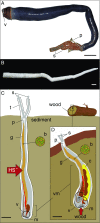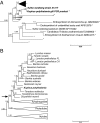Discovery of chemoautotrophic symbiosis in the giant shipworm Kuphus polythalamia (Bivalvia: Teredinidae) extends wooden-steps theory
- PMID: 28416684
- PMCID: PMC5422788
- DOI: 10.1073/pnas.1620470114
Discovery of chemoautotrophic symbiosis in the giant shipworm Kuphus polythalamia (Bivalvia: Teredinidae) extends wooden-steps theory
Abstract
The "wooden-steps" hypothesis [Distel DL, et al. (2000) Nature 403:725-726] proposed that large chemosynthetic mussels found at deep-sea hydrothermal vents descend from much smaller species associated with sunken wood and other organic deposits, and that the endosymbionts of these progenitors made use of hydrogen sulfide from biogenic sources (e.g., decaying wood) rather than from vent fluids. Here, we show that wood has served not only as a stepping stone between habitats but also as a bridge between heterotrophic and chemoautotrophic symbiosis for the giant mud-boring bivalve Kuphus polythalamia This rare and enigmatic species, which achieves the greatest length of any extant bivalve, is the only described member of the wood-boring bivalve family Teredinidae (shipworms) that burrows in marine sediments rather than wood. We show that K. polythalamia harbors sulfur-oxidizing chemoautotrophic (thioautotrophic) bacteria instead of the cellulolytic symbionts that allow other shipworm species to consume wood as food. The characteristics of its symbionts, its phylogenetic position within Teredinidae, the reduction of its digestive system by comparison with other family members, and the loss of morphological features associated with wood digestion indicate that K. polythalamia is a chemoautotrophic bivalve descended from wood-feeding (xylotrophic) ancestors. This is an example in which a chemoautotrophic endosymbiosis arose by displacement of an ancestral heterotrophic symbiosis and a report of pure culture of a thioautotrophic endosymbiont.
Keywords: Teredinidae; chemoautotrophy; shipworm; symbiosis; thioautotrophy.
Conflict of interest statement
The authors declare no conflict of interest.
Figures




Comment in
-
Zoology: Molluscs All Beneath the Sun, One Shell, Two Shells, More, or None.Curr Biol. 2017 Jul 24;27(14):R708-R710. doi: 10.1016/j.cub.2017.05.075. Curr Biol. 2017. PMID: 28743018
References
-
- Huber M. Compendium of Bivalves 2. A Full-Color Guide to the Remaining Seven Families. A Systematic Listing of 8,500 Bivalve Species and 10,500 Synonyms. ConchBooks; Hackenheim, Germany: 2015.
-
- Turner RD. A Survey and Illustrated Catalogue of the Teredinidae (Mollusca: Bivalvia) The Museum of Comparative Zoology, Harvard University; Cambridge, MA: 1966.
Publication types
MeSH terms
Associated data
- Actions
- Actions
- Actions
- Actions
- Actions
- Actions
- Actions
- Actions
Grants and funding
LinkOut - more resources
Full Text Sources
Other Literature Sources

